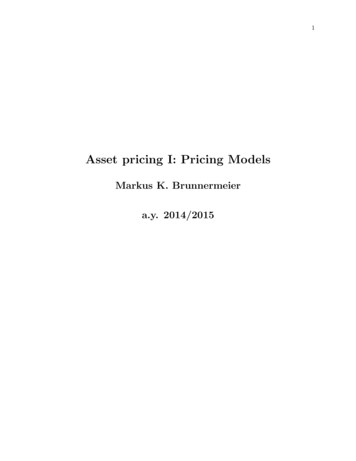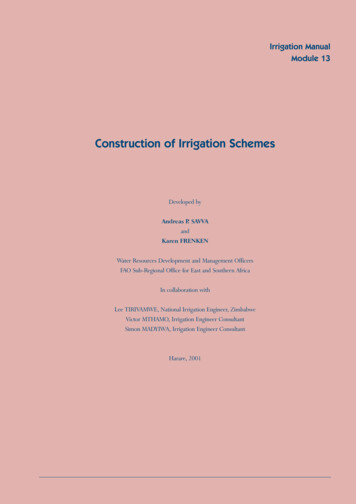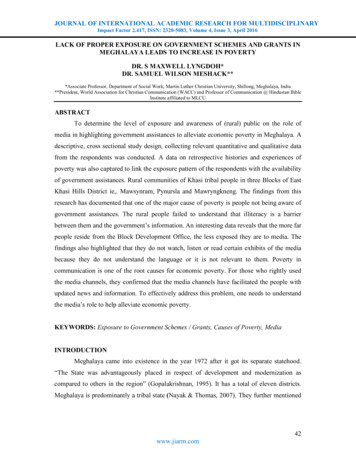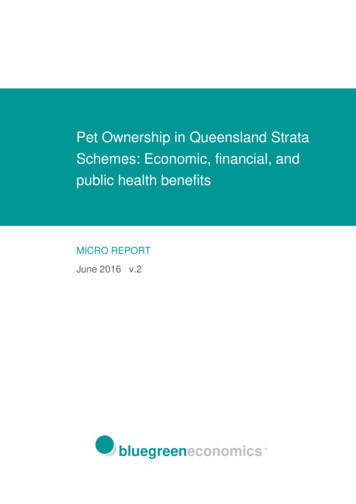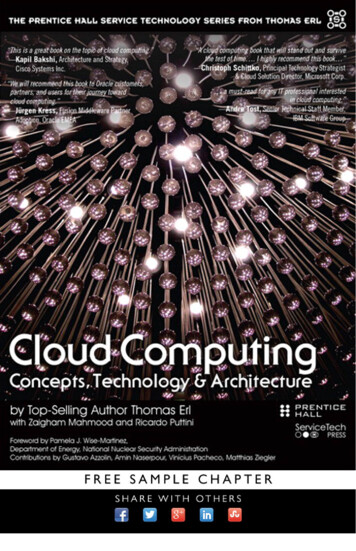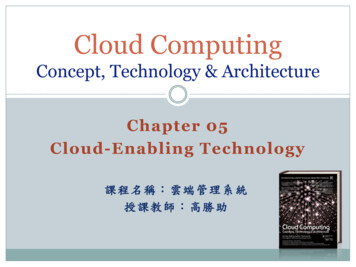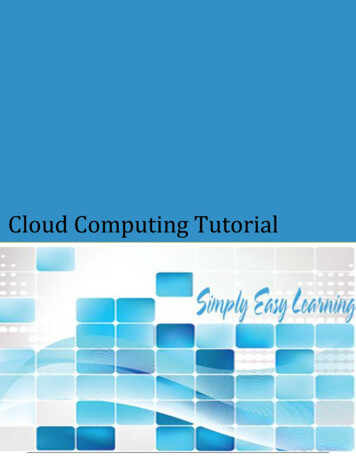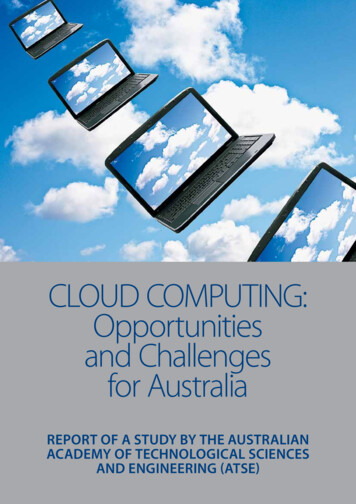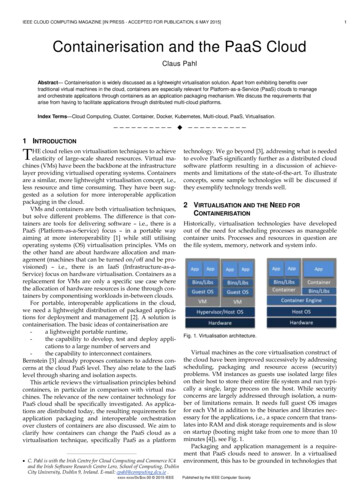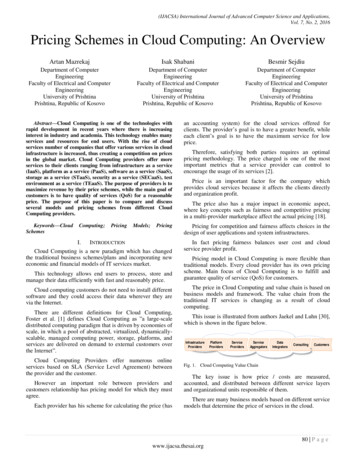
Transcription
(IJACSA) International Journal of Advanced Computer Science and Applications,Vol. 7, No. 2, 2016Pricing Schemes in Cloud Computing: An OverviewArtan MazrekajIsak ShabaniBesmir SejdiuDepartment of ComputerEngineeringFaculty of Electrical and ComputerEngineeringUniversity of PrishtinaPrishtina, Republic of KosovoDepartment of ComputerEngineeringFaculty of Electrical and ComputerEngineeringUniversity of PrishtinaPrishtina, Republic of KosovoDepartment of ComputerEngineeringFaculty of Electrical and ComputerEngineeringUniversity of PrishtinaPrishtina, Republic of KosovoAbstract—Cloud Computing is one of the technologies withrapid development in recent years where there is increasinginterest in industry and academia. This technology enables manyservices and resources for end users. With the rise of cloudservices number of companies that offer various services in cloudinfrastructure is increased, thus creating a competition on pricesin the global market. Cloud Computing providers offer moreservices to their clients ranging from infrastructure as a service(IaaS), platform as a service (PaaS), software as a service (SaaS),storage as a service (STaaS), security as a service (SECaaS), testenvironment as a service (TEaaS). The purpose of providers is tomaximize revenue by their price schemes, while the main goal ofcustomers is to have quality of services (QoS) for a reasonableprice. The purpose of this paper is to compare and discussseveral models and pricing schemes from different CloudComputing providers.an accounting system) for the cloud services offered forclients. The provider’s goal is to have a greater benefit, whileeach client’s goal is to have the maximum service for lowprice.Keywords—CloudSchemesPricing for competition and fairness affects choices in thedesign of user applications and system NTRODUCTIONCloud Computing is a new paradigm which has changedthe traditional business schemes/plans and incorporating neweconomic and financial models of IT services market.This technology allows end users to process, store andmanage their data efficiently with fast and reasonably price.Cloud computing customers do not need to install differentsoftware and they could access their data wherever they arevia the Internet.There are different definitions for Cloud Computing,Foster et al. [1] defines Cloud Computing as ”a large-scaledistributed computing paradigm that is driven by economies ofscale, in which a pool of abstracted, virtualized, dynamicallyscalable, managed computing power, storage, platforms, andservices are delivered on demand to external customers overthe Internet”.Cloud Computing Providers offer numerous onlineservices based on SLA (Service Level Agreement) betweenthe provider and the customer.However an important role between providers andcustomers relationship has pricing model for which they mustagree.Each provider has his scheme for calculating the price (hasTherefore, satisfying both parties requires an optimalpricing methodology. The price charged is one of the mostimportant metrics that a service provider can control toencourage the usage of its services [2].Price is an important factor for the company whichprovides cloud services because it affects the clients directlyand organization profit.The price also has a major impact in economic aspect,where key concepts such as fairness and competitive pricingin a multi-provider marketplace affect the actual pricing [18].In fact pricing fairness balances user cost and cloudservice provider profit.Pricing model in Cloud Computing is more flexible thantraditional models. Every cloud provider has its own pricingscheme. Main focus of Cloud Computing is to fulfill andguarantee quality of service (QoS) for customers.The price in Cloud Computing and value chain is based onbusiness models and framework. The value chain from thetraditional IT services is changing as a result of cloudcomputing.This issue is illustrated from authors Jaekel and Luhn [30],which is shown in the figure ltingCustomersFig. 1. Cloud Computing Value ChainThe key issue is how price / costs are measured,accounted, and distributed between different service layersand organizational units responsible of them.There are many business models based on different servicemodels that determine the price of services in the cloud.80 P a g ewww.ijacsa.thesai.org
(IJACSA) International Journal of Advanced Computer Science and Applications,Vol. 7, No. 2, 2016For example below we see an illustration of a model forCloud Computing cost accounting [14] which addresses costaccounting issues in production of cloud services.SaaSService 1PaaSService 2Service 3Platform 1Platform 2InfrastructureInstance PriceCloud FixedCostVirtual MachineCostHardware CostMaintenace CostServer CostSoftware CostNetwork CostCooling CostFacilities CostRack CostPower CostReal-Estate CostFig. 2. Cloud Computing cost accounting modelIn this paper we focus on review and comparing prices ofsome models, some pricing schemes which are provided bycloud service providers, based on services provided, theirquality, fairness price and significance in the market.II.Patel and Shah [4] studied for prices caused bydatacenters, which focused on three issues: space, power andcooling on cost model. They analyzed the price for each of thethree cases and the sum of these prices to show a pricecomparison operating in datacenter. The authors of this studydo not go any further in finding the cost of Cloud resourcesmeant to be sold as a service.Pal and Hui [5] have studied an economic model for fixingprices of resources. They used game theory and havepresented some economic models. In first model, QoSguarantees provided by cloud provider are pre-specified andfixed competitors compete for prices. In another model, cloudproviders compete for QoS level as well as prices for aparticular application.IaaSCloudUtilization Costfocused on the initial price however did not take underconsideration the maintenance costs.RELATED WORKIn this section we discuss related work with regard to thepricing schemes in Cloud Computing.The issue of price in the cloud in terms of relationshipbetween providers and customers is treated by many authors,which have analyzed different schemes and models intheoretical aspects and simulated through different software.Sharma et al., [3] proposed a novel financial economicmodel capable of providing a high level of QoS to customers.They developed a financial option theory treating cloudresources as assets. The price determined by their modelrepresents an optimal price where the provider charges theclient in order to cover the initial cost.Also, indirectly they have used Moore's law to determinethe price of resources in the cloud and Black-Scholes-Merton(BSM) model that treats cloud resources as assets.Through their experiments and simulations, they analyzedthe effect of initial investment, effect of contract period, effectof rate of depreciation, effect of quality of service, effect ofage of the resources on the resource price. The authorsWang et al. [6] proposed an algorithmic solution tooptimize data center net profit with deadline-dependentscheduling by jointly maximizing revenues and minimizingelectricity costs. They developed two distributed algorithmsfor the net profit optimization: Net Profit Optimization forDivisible jobs (NPOD), and Net Profit Optimization forIndivisible Jobs (NPOI). The authors proved via simulationstheir algorithm’s capabilities to increase revenues and reduceelectricity costs by comparing it to the Largest Job First (LJF)algorithm. The authors considered only static job arrivals anddepartures. They also assumed that the servers at all datacenters were homogenous, which is not realistic [2].Yeoa et al. [7] analyzed difference between fixed andvariable prices. Fixed prices were easier to understand andmore straightforward for users. However, fixed prices couldnot be fair to all users because not all users had the sameneeds. They proposed charging variable prices with advancedreservation, in which case users know the exact expenses thatare computed at the time of reservation even though they werebased on variable prices.Macias and Guitart [8] proposed a genetic model forpricing in cloud computing markets. Choosing a good pricingmodel via their genetic algorithms involved three main steps:define a chromosome, evaluate it, and finally select the bestpairs of chromosomes for reproduction and discarding thosewith the worst results. The results of the simulation illustratedthat genetic pricing acquired the highest revenues in most ofthe scenarios. Service providers employing genetic pricingachieved revenues up to 100% greater than the other dynamicpricing strategies and up to 1000% greater than the fixedpricing strategy.Li at al. [19] proposed a pricing algorithm for cloudcomputing resources. Authors proposed the cloud bank agentmodel as a resource agency from the global perspective, whichprovides analysis and guidance for all members.The model analyses the historical utilization ratio of theresource, and iteration current prices constantly, get theavailability of resources next time, the final price to users areexpected to calculate. The proposed pricing model could notadapt to the rapid changes that occur in the market.81 P a g ewww.ijacsa.thesai.org
(IJACSA) International Journal of Advanced Computer Science and Applications,Vol. 7, No. 2, 2016III.PRICING SCHEMES IN THE CLOUDHere we present an overview of pricing schemes from theperspective of the accounting process and the relevance fromthe business model. There are various pricing schemesdepending on the cloud service provider. The challenge ofservice providers is to provide good services for reasonableprice to users. The pricing should be based on customer’sperceived value instead of production costs of services.Some of the definitions and short description of pricingschemes and which vary depending on the services are [11]: Time based, pricing based on how long a service isused; Volume based, pricing based on the volume of a metric; Flat rate, a fixed tariff for a specified amount of time. Priority pricing, services are labeled and pricedaccording to their priority; Edge pricing, calculation is done based on the distancebetween the service and the user; Responsive pricing, charging is activated only onservice congestion;In the following table are presented some of the pricingschemes for some providers for pay-per-use pricingmechanism [16].TABLE I.PRICING SCHEMES FOR PAY-PER-USEServicePricing schemeAmazon Web Services /Elastic Compute Cloud(EC2)Amazon Web Service / SimpleStorage Service (S3) Charges on hourly for usage theRAM, CPU Charge per transferred GB basis- Charge per GB of storage- Charge per data transferred in GB- Charge on hourly basis for processingpower and on per GB for storageMicrosoft AzureAppNexus / AppNexus CloudSource: appnexus.com- Charge on hourly basisSubscription pricing, users pay on a recurring basis toaccess software as an online service or to profit from a service.The customer subscribes to use a preselected combinationof service units for a fixed price and a longer time frame,usually monthly or yearly [15].In the following table are presented some of the pricingschemes for some providers for subscription pricingmechanism. Session-oriented, based on the use given to the session;TABLE II.PRICING SCHEMES FOR SUBSCRIPTION Usage-based, based on the general use of the servicefor a period of time, e.g. a month;ServicePricing scheme Content-based, based on the accessed content;Dropbox / Dropbox cloudstoragePricing assigned for stored in GB [17] Location-based, based on the access point of the user;Google / App Engine- Charges on monthly basis- Charge per user basis- Pricing on hourly basisAmazon Web Services /Elastic Compute Cloud(EC2)It allows for the reservation of units Service type, based on the usage of the service; Free of charge, no charge is applied for the services; Periodical fess, payment of time to time quantities forthe use of a service;Microsoft Azure Pre-paid, the payment of the service is done inadvance. Post-paid, the payment of the service is done after theuse; Online, the accounting performed while the user makesuse of a service; Offline, the accounting process is done after a service isused;A. Fixed PricingEach service provider defines price for resources thatcould be prohibitive and thus lead to a reduced customer baseand decrease in revenue and profits. Fixed pricing includespricing mechanism as pay-per-use pricing, subscription andlist price / menu price [14].Pay-per-use pricing, users only have to pay for what theyuse. Customer pays in function of the time or quantity heconsumes on a specific service. Pay-per-use makes usersaware of the cost of doing business and consuming a resource.Salesforce / Salesforce.com- Charges on monthly basis, dependingfrom number of transactions- Charges on monthly basissubscription for databaseSource: Microsoft Azure website- price assigned on monthly basis peruserHybrid pricing model (pay-per-use plus subscription), inthis model between per-per-use and subscription, dedicatedservers must be provided in advance for a period of time [16].In the following table are presented some of the pricingschemes for some providers for hybrid (pay-per-use plussubscription) pricing mechanism.TABLE III.ServiceGoogle / App EngineJoynet / Smart MachinesSource: joynet.comHYBRID PRICING SCHEMESPricing scheme- Price assigned on monthly basis- If limit exceeds then charge on per GBand processing power on hourly basis- Price assigned on monthly basis for thepackage- If the usage exceeds the limit thecharges on per GB82 P a g ewww.ijacsa.thesai.org
(IJACSA) International Journal of Advanced Computer Science and Applications,Vol. 7, No. 2, 2016List Price / Menu Pri
Cloud Computing cost accounting [14] which addresses cost accounting issues in production of cloud services. Fig. 2. Cloud Computing cost accounting model In this paper we focus on review and comparing prices of some models, some pricing schemes which are provided by cloud service providers, based on services provided, their quality, fairness price and significance in the market. II. RELATED .
